Rescuing a windsurfer with a safety boat is an essential skill of any watersports instructor.
If you add 20 knots of wind then things can become tricky. At Flying Fish we specialise in teaching these skills to all our students who wish to work in the best (and windiest) windsurfing locations around the world.
We believe the key is to break it down into the individual elements and keep it simple.
There are two parts to the rescue, the person and the equipment.
The person is always number one priority. There may be times when the human is the only thing you pick up and the equipment is dealt with later.
NB. The kill cord is worn at all times during these rescues.
Although this article and video is entitled ‘high’ wind windsurf rescue, this technique works just as well in low wind. However, the likelihood is that more people need rescuing in higher wind and that’s when things become more serious.
We also know that non windsurf instructors are asked to man safety boats, so we wanted to give them a model to work with as well.
When we teach the high wind rescue technique we break it down into two clear parts to keep things simple. The person and then the equipment.
The Person: Number 1 Priority
When approaching a windsurfer think of the person as the most important aspect and the kit is only a second thought.
Begin from around 8-10 boat lengths downwind of the person slowly and under control.
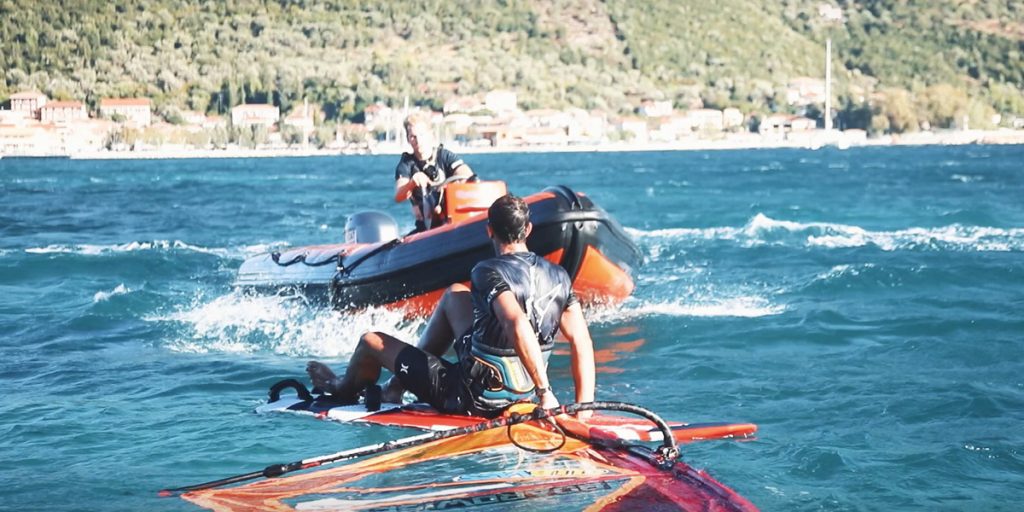
At two boat lengths signal to the person to see if they are OK and to ask them to climb onto the board. This is much better than trying to recover them from the water.
If you have a radio let the tower or beach control know what you are doing. Communication is key within a good rescue team.
Keeping one hand on the wheel and one hand on the throttle, pull the rescue boat alongside the board on the opposite side to the sail. This can be practised with other items such as moored boats, jetty’s and windsurfers in light wind before going into a high wind scenario.
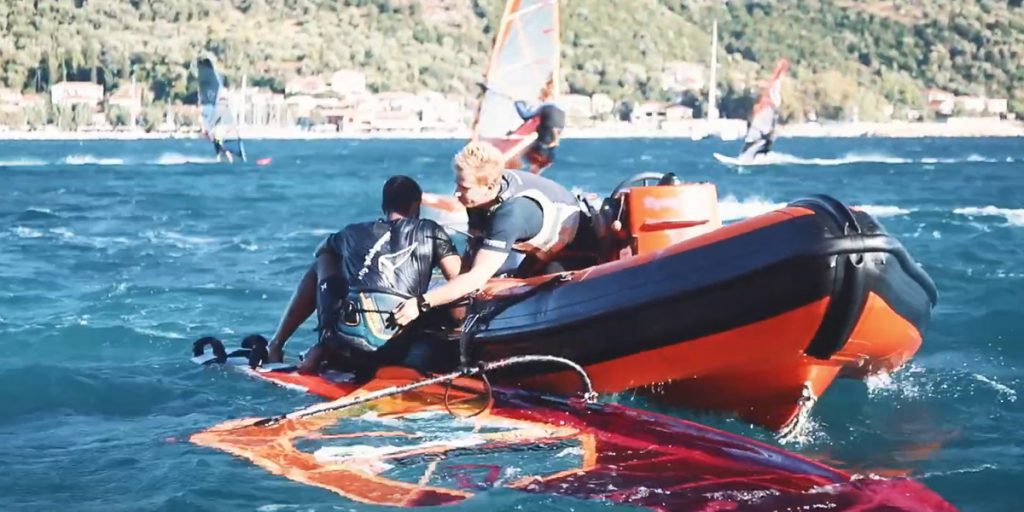
Remember to turn off the engine when transferring people between boats and equipment.
Talk to the person constantly through the rescue, this allows you to asses their levels of response and reassures them at the same time. Make sure the individual knows where to sit in the boat and keep them in your view.
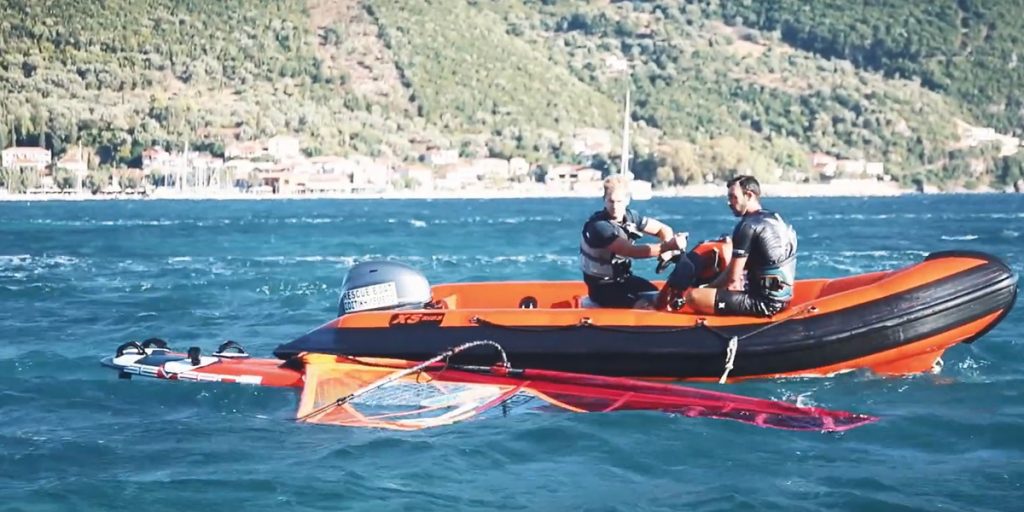
Once the person is comfortable and holding on where you can see them in the boat, only then you can think about the equipment.
The Windsurf Kit
Remember you can always buy more kit, but you can’t buy more people!
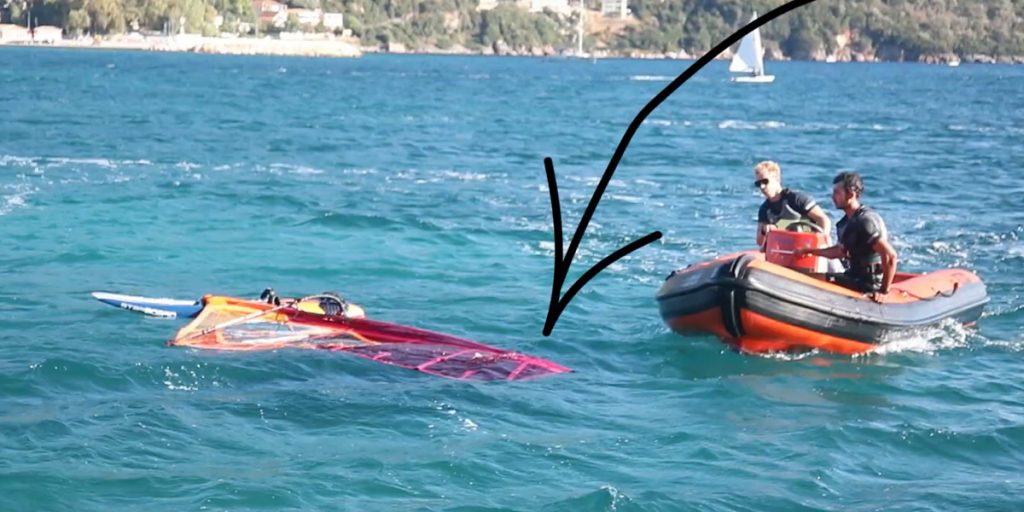
Approach the equipment from downwind, turn the engine off and aim to bring the tip of the mast in at 90 degrees to the side of the boat.
Free the sail from the water using the mast tip.
Flip the sail if needed and using a wide grip on the mast, direct the board along side the boat.
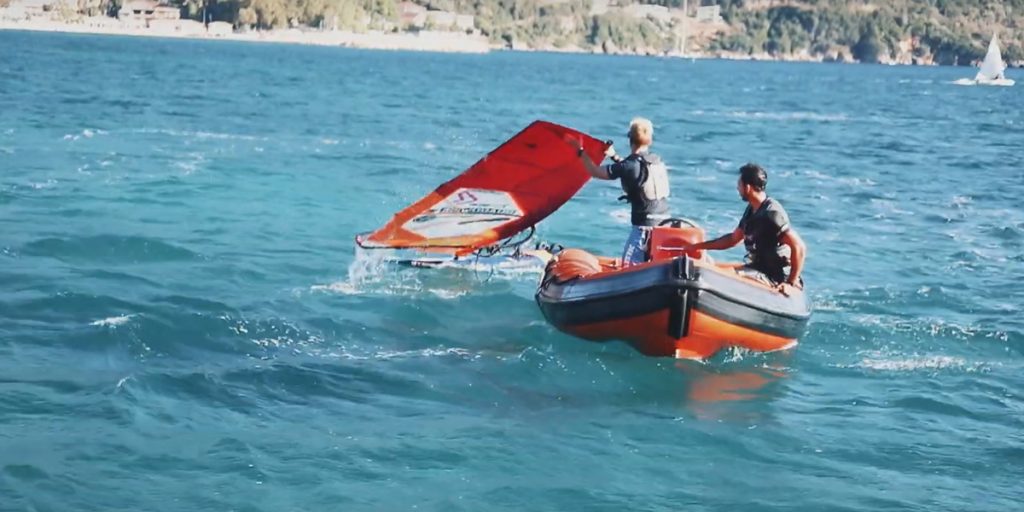
Bring the boom in till it touches the tube.
Many keen windsurfers will want to help with this process but it’s much better if they don’t get involved until the rig is in the right place.
At this point you can move the person to begin sitting over the mast and onto the sail if possible.
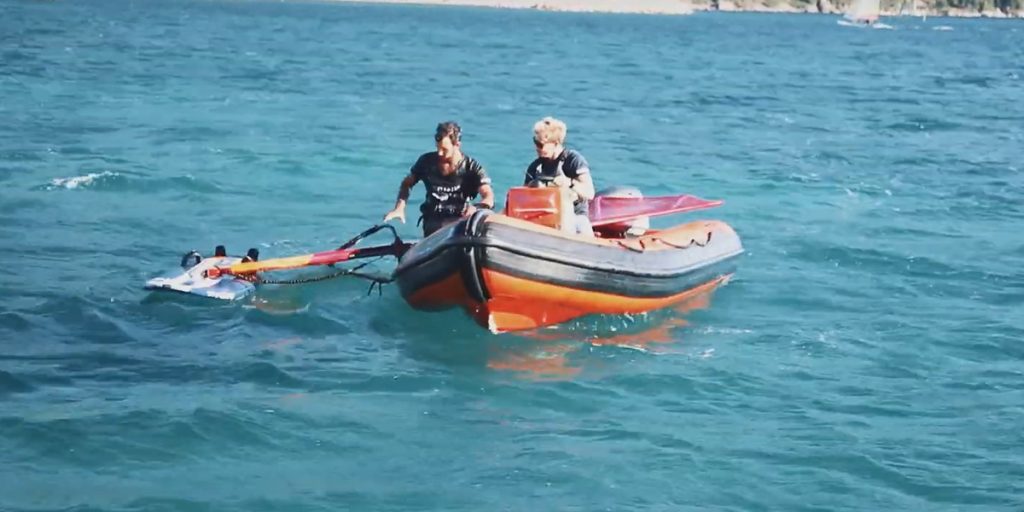
Drive towards the beach at a speed that matches the wind and size of the waves. On a windy day you may not be able to go as fast but as long as everything stays safe then that’s all that matters.
Keep an eye on where you are going and what is around you. Watch the nose of the board to ensure it does not dig in or fly up in the air.
Towing Long Distances Or In High Wind
There may be times when the water gets rough and the wind goes up a level or you could be dealing with a light weight windsurfer.
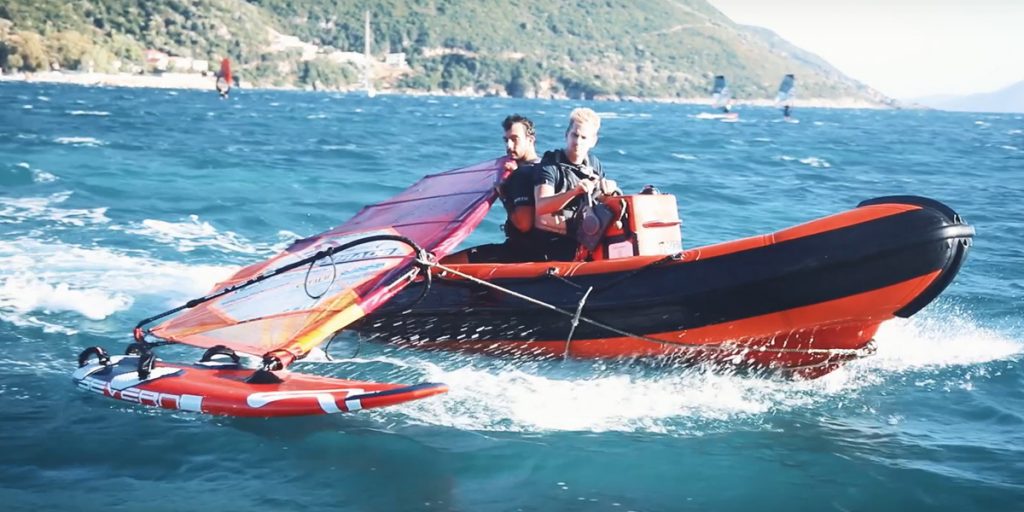
The technique of using the painter (the rope from the D ring at the front of the boat) can help you solve these problems. However this must be done with care especially in waves.
It’s quite rare to need to tow a windsurfer a long distance, but it’s generally a useful skill to have.
Once you have safely recovered the person and the kit, the painter can either go around the boom and back onto itself or around the boom and onto the safety line on the tube. Be aware that karabiners can be difficult to detach in an emergency when under strain.
Position the windsurfer on the middle seat facing backwards and get them to push on the mast. This will create mast foot pressure and stick the board to the water as you proceed.
Care must be taken to ensure the board does not dig in to a wave along the way.
What To Do With An Injured Windsurfer?
When dealing with an injured windsurfer the process it actually more simple.
Firstly, once you establish there is an injury the beach must be notified via VHF radio, ask for backup at this point if required.
Remembering to switch the engine off, the slow careful approach from downwind is the same as normal. Using the board as a platform to transfer the injured person into the powerboat is still the best plan.
If this is not possible there are other methods such as rope ladders or loops or even deflating a tube (preferably the downwind side).
Its a good idea to practice these options before finding yourself in the situation for real.
All scenarios are covered as part of the Windsurf Instructor Course in Vassiliki. Once the person is comfortably placed in the safety boat, attach the rescue aware buoy to the kit, abandon it and proceed to the shore.
The underlying rule is that you, as the rescuer, are the most important person. Take great care not to injure yourself or put yourself at risk while doing any rescue.
Crosshore Considerations In Vassiliki
One of the reasons Vassiliki is such a perfect training ground for windsurfers and windsurf instructors is that we experience strong crosshore conditions in the afternoon.
The Katabatic wind is thermally accelerated by rising over and falling down our mountain ‘Eric’. The strong wind always comes from the same direction.
Because of this we teach our Flying Fish students to pick up the equipment on the starboard side of the rib. Therefore when on the way back to the beach the kit will always be on the downwind side, so if a mega gust comes the kit will blow free of the boat and not injure anyone.
Where To Position A Rescue Boat
Many of the things that make you a good safety boat driver are done before even getting to a rescue.
These included safety equipment checks, VHF radio checks and fuel checks.
But an equally important consideration is where you position your rescue boat.
The best place to be is downwind.
Therefore you are not in the way and do not risk a collision with the majority of windsurfers and other craft that are competently sailing around.
The main point is that anyone needing a rescue will naturally come to you.
Drifting downwind is common when going through the learning process of windsurfing on smaller boards and higher wind.
Be aware this does not mean a windsurfer drifting downwind will definitely need a rescue and they may just need a pointer to return to shore and walk back up the sand bar. Falling in and learning to waterstart are all part of the process of learning this rewarding sport.
Rescuing A Wind Foil
Wind foiling is the new sensation to take over the watersports world and is gaining more popularity each day. This has been recently boosted by the fact that windfoiling has been announced as the new Olympic discipline within the sport of sailing. This has resulted in new considerations for safety boat drivers carrying out rescues.
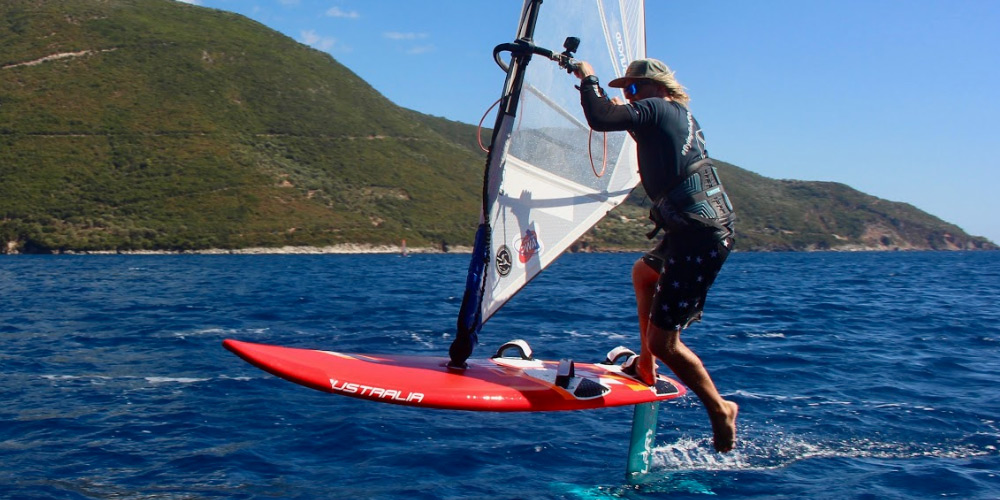
We believe there are two main options when rescuing a windfoil:
1. Drive Slow Homey
Due to the fact that you have an airplane on a stick connected to the bottom of the board it’s important to take a care.
Approach the windfoil board in the normal way and transfer the person as per the technique shown in our video.
Once the person is successfully transferred and is safely in the boat, you can re start the engine and go about recovering the kit in the normal way. The only difference is that you will have to drive at around 10% of the speed possible with a normal windsurfer.
Keep an eye on the board to make sure that the boat speed doesn’t create too much lift from the foil.
2. The Switcharoo
Due to the fact many people are currently learning or expressing an interest to wind foil, this means the amount of windfoil instructors is increasing.
Hopefully there is more likely to be a windfoil instructor close at hand or at least someone who is competent. The switcharoo method allows the swift rescue of the person and could also be the chosen technique for an injured windfoiler.
Approach the equipment from downwind as normal, taking extra care around the back of the board (the foil sticks out further than you think).
Pull alongside the board, switch the engine off and carefully transfer the individual. Apply the rescue aware buoy (see injured windsurfer section of the video).
Using the VHF radio tell the beach that you are coming in and request a competent wind foiler to meet you at the shoreline. Exchange the client for that member of staff and take them to the foil so they can sail it home and you are free to carry on other rescue duties.
We find this method to be faster with less chance of human or equipment damage.
The Last Resort
There is a third option of rescuing a wind foiler or any windsurfer for that matter, its called the full de-rig.
This method entails taking the equipment apart on the water and breaking it down into smaller parts which all fit into the safety boat.
Be careful about damaging people or kit while doing this. We tend to use this as a last resort or when the equipment is already broken. Again, always use the radio to let the beach control know what you are doing and don’t be afraid to ask for backup.
Windsurf rescue will be covered as part of an RYA Safety Boat Course, as well as the Windsurfing Instructor Course.
We recommend all safety boat drivers to have training on windsurf rescue, as when it gets windy the experienced windsurfers tend to be the ones out on the water.
Its the sailing instructors and other water sports staff that can be asked to man the safety boat on such occasions.
How To Be A Great Safety Boat Driver
Every rescue you do will be slightly different so apply these Golden Rules for success:
1. Always wear your killcord
2. Keep one hand on the wheel and one hand on the throttle
3. Always switch the engine off prior to transferring people or recovering equipment, (unless dangerous to do so).
4. Make sure everyone is secure in the boat before moving away
5. People before kit. If you need to ditch the kit to keep people safe then do so.
6. Keep your radio on and communicate with your base, always use your back up.
7. Practice with an experienced instructor who can give you feedback.
8. Before going on a rescue shift you can refresh your memory by watching our 1 minute rescue summary video.
Feel free to contact us about any of the advice raised in this article. Or check out the other How to Videos on our Youtube Channel.
Stay safe everyone!





Recent Comments